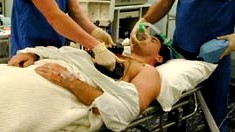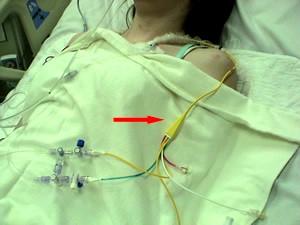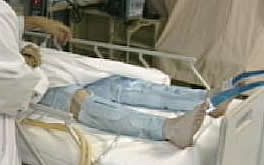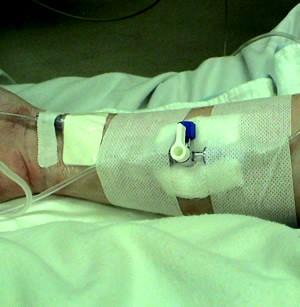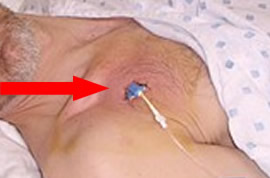|
Cardioversion is the use of a defibrillator when a person is not in cardiac arrest but has an abnormal heart rhythm. Sometimes the team will try to ‘shock’ a heart back into a normal rhythm. The patient will be given sedatives and pain relief before undergoing cardioversion. Defibrillation is the term used to describe this treatment when the heart is not pumping effectively at all. The heart may have stopped, or it could be ‘fibrillating’ or quivering, without pumping any blood. The shock of defibrillation can stop the heart and allow it to restart at a normal rhythm. |
|
| Bolus | A large volume of fluid (i.e. 500 mL) given all at once increases the volume in the blood circulation and can raise the blood pressure. |
| Intra-aortic balloon pump (IABP) | If a person’s heart is not pumping well enough to get oxygen and nutrients to the body, they may be given the support of an IABP. The IABP sits in the aorta, the major artery from the heart. It is placed in the aorta through a large artery in the leg and threaded into place. The pressure settings on the pump are watched very closely to make sure they are effective. |
| Also called a Pulmonary Artery Catheter. A Swan Ganz catheter is a catheter inserted into the right side of the heart via a large central vein. This catheter is used when the team requires detailed information about heart function. The tip of the catheter sits in the artery just before the lungs. A Swan-Ganz catheter looks at different blood pressures and is used to guide the medical staff to choose certain treatments for those critically ill patients. | |
| The legs are a common place for clots called DVTs to form. Compression stockings and Sequential Compression Devices can help prevent DVTs by helping blood return from the legs to the heart. | |
|
Also called an arterial line, or art line. This is usually inserted in an artery at the wrist. Blood gases need to be measured frequently in the MSICU. An arterial line provides a point of access for blood tests. The catheter is used to closely monitor blood pressure. The blood in arteries is under high pressure, so the arterial line is hooked up to an pressurized box that runs a small amount of fluid into the line to prevent clotting. The line is flushed after every use to keep it free of clots as well. |
|
|
|
A line inserted into a vein, usually on the hand or arm. IVs are used to give medication and fluids without having to stick a patient with any more needles than necessary. |
|
Most patients in the MSICU will have a central venous catheter. Central lines, or central IVs are similar to regular IVs, but they are placed in a larger vein close to the right side of the heart. Central lines can be used in the same way as regular IVs, and can also be used to give nutrition and medications that may harm smaller veins. There is a lot more blood flowing through a central vein, so anything that is given gets diluted or watered down quickly, reducing the chance of irritation. Central venous catheters can also be used to measure certain blood pressures. Samples can be drawn to measure the blood gases as well. |
|
|
Peripherally Inserted Central Catheter (PICC line)
|
Another type of Central Venous Catheter is a PICC line. A PICC line is a long, thin IV that is often inserted into the arm and advanced until the tip of the catheter is located in a large central vein. These catheters can be inserted at the bedside by specially trained nurses. |

